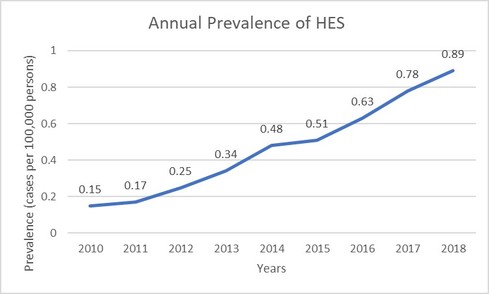
Contributions
Abstract: EP1122
Type: E-Poster Presentation
Session title: Myeloproliferative neoplasms - Clinical
Background
Hypereosinophilic syndrome (HES) is a group of rare hematologic disorders of unknown etiology defined by sustained eosinophilia associated with organ damage. The burden of this rare condition is not yet well characterized. Reliable estimates of the incidence and/or prevalence of the disease are not readily available, since most publications are case reports without clear details of the population from which they are drawn.
Aims
To explore the incidence and prevalence of HES using UK real-world primary care data.
Methods
Primary care data from the UK Clinical Practice Research Datalink (CPRD) GOLD and Aurum databases, were analyzed. Patients of interest were identified using medical codes specific for HES and for chronic eosinophilic leukemia not otherwise specified (CEL-NOS) as a subtype. Annual incidence rates and prevalence were estimated for the years 2010 to 2018 (inclusive) based on the assumption that patients with diagnosed HES would be identified if they were followed for at least 365 days within CPRD. For calculations of incidence, patients with no records of HES within the first 365 days of observation were considered disease-free and hence “at risk” of developing HES in the future. For calculations of prevalence, HES patients were identified from the population of patients who were continually registered for the full calendar year of interest; their HES diagnosis could occur either during or at any time before the calendar year of interest. The impact of this assumption was tested in additional sensitivity analyses applying a minimum observation period of 730 days (two years) or 1035 days (three years) to identify existing prevalent cases.
Results
During the study period, 93 patients were identified with a first diagnosis of HES, 57% were male, with a mean (SD) age of 57.0 (19.3) years. Of these, 12 patients had a diagnosis of CEL-NOS; they were slightly older (average age of 67 years) and predominantly male (92%). From 2010 to 2018, the overall annual incidence rate of patients diagnosed with HES ranged from <0.04 to 0.17 per 100,000 person-years and the overall annual prevalence ranged from 0.15 to 0.89 cases per 100,000 persons (Figure 1). Sensitivity analyses based on minimum observation periods of two and three years gave similar results.

Conclusion
These results provide estimates of the burden of HES in the UK and indicate that whilst HES is a very rare disease, there is evidence that it is increasingly being recorded in UK primary care. We discuss potential explanations for the patterns seen.
Funding: [GSK 208701][DG1] This study was reviewed and approved by ISAC (protocol number 18_242).
Keyword(s): Hypereosinophilic syndrome, Incidence, Prevalence
Abstract: EP1122
Type: E-Poster Presentation
Session title: Myeloproliferative neoplasms - Clinical
Background
Hypereosinophilic syndrome (HES) is a group of rare hematologic disorders of unknown etiology defined by sustained eosinophilia associated with organ damage. The burden of this rare condition is not yet well characterized. Reliable estimates of the incidence and/or prevalence of the disease are not readily available, since most publications are case reports without clear details of the population from which they are drawn.
Aims
To explore the incidence and prevalence of HES using UK real-world primary care data.
Methods
Primary care data from the UK Clinical Practice Research Datalink (CPRD) GOLD and Aurum databases, were analyzed. Patients of interest were identified using medical codes specific for HES and for chronic eosinophilic leukemia not otherwise specified (CEL-NOS) as a subtype. Annual incidence rates and prevalence were estimated for the years 2010 to 2018 (inclusive) based on the assumption that patients with diagnosed HES would be identified if they were followed for at least 365 days within CPRD. For calculations of incidence, patients with no records of HES within the first 365 days of observation were considered disease-free and hence “at risk” of developing HES in the future. For calculations of prevalence, HES patients were identified from the population of patients who were continually registered for the full calendar year of interest; their HES diagnosis could occur either during or at any time before the calendar year of interest. The impact of this assumption was tested in additional sensitivity analyses applying a minimum observation period of 730 days (two years) or 1035 days (three years) to identify existing prevalent cases.
Results
During the study period, 93 patients were identified with a first diagnosis of HES, 57% were male, with a mean (SD) age of 57.0 (19.3) years. Of these, 12 patients had a diagnosis of CEL-NOS; they were slightly older (average age of 67 years) and predominantly male (92%). From 2010 to 2018, the overall annual incidence rate of patients diagnosed with HES ranged from <0.04 to 0.17 per 100,000 person-years and the overall annual prevalence ranged from 0.15 to 0.89 cases per 100,000 persons (Figure 1). Sensitivity analyses based on minimum observation periods of two and three years gave similar results.

Conclusion
These results provide estimates of the burden of HES in the UK and indicate that whilst HES is a very rare disease, there is evidence that it is increasingly being recorded in UK primary care. We discuss potential explanations for the patterns seen.
Funding: [GSK 208701][DG1] This study was reviewed and approved by ISAC (protocol number 18_242).
Keyword(s): Hypereosinophilic syndrome, Incidence, Prevalence


